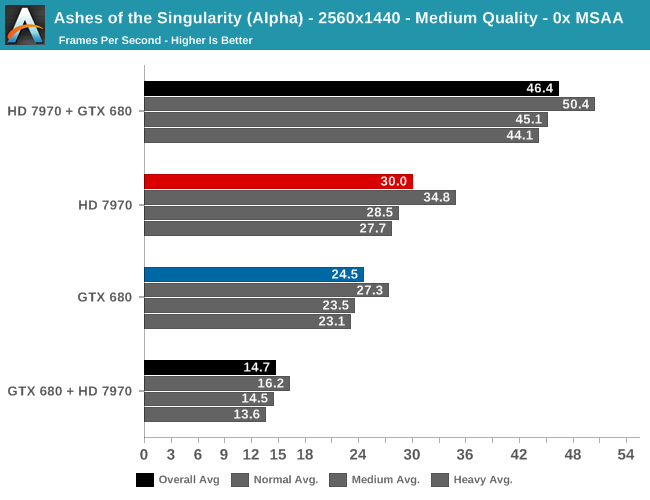GeForce + Radeon: Previewing DirectX 12 Multi-Adapter with Ashes of the Singularity
by Ryan Smith on October 26, 2015 10:00 AM ESTAshes GPU Performance: Single & Mixed 2012 GPUs
While Ashes’ mutli-GPU support sees solid performance gains with current-generation high-end GPUs, we wanted to see if those gains would extend to older DirectX 12 GPUs. To that end we’ve put the GeForce GTX 680 and the Radeon HD 7970 through a similar test, running the Ashes’ benchmark at 2560x1440 with Medium image quality and no MSAA.

First off, unlike our high-end GPUs there’s a distinct performance difference between our AMD and NVIDIA cards. The Radeon HD 7970 performs 22% better here, just averaging 30fps to the GTX 680’s 24.5fps. So right off the bat we’re entering an AFR setup with a moderately unbalanced set of cards.
Once we do turn on AFR, two very different things happen. The GTX 680 + HD 7970 setup is an outright performance regression, with performance 40% from the single GTX 680 Ti. On the other hand the HD 7970 + GTX 680 setup sees an unexpectedly good performance gain from AFR, picking up a further 55% to 46.4fps.
As this test is a smaller number of combinations it’s not clear where the bottlenecks are, but it’s none the less very interesting how we get such widely different results depending on which card is in the lead. In the GTX 680 + HD 7970 setup, either the GTX 680 is a bad leader or the HD 7970 is a bad follower, and this leads to this setup spinning its proverbial wheels. Otherwise letting the HD 7970 lead and GTX 680 follow sees a bigger performance gain than we would have expected for a moderately unbalanced setup with a pair of cards that were never known for their efficient PCIe data transfers. So long as you let the HD 7970 lead, at least in this case you could absolutely get away with a mixed GPU pairing of older GPUs.










180 Comments
View All Comments
Gigaplex - Tuesday, October 27, 2015 - link
Intel's top iGPUs can beat AMDs top ones, but expect to pay a premium.loguerto - Sunday, November 1, 2015 - link
I love how intel managed to implement ondie ram as a workaround to the ddr3 huge bottleneck. I wonder why AMD did not cosed to do the same as their 7870k is evidently bottlenecked by the ddr3, is there a cost problem or they are waiting to switch directly on the hbm memory?CiccioB - Tuesday, October 27, 2015 - link
A test with the Titan X as master card would be interesting. It may show if the sync problem is HW or SW related.Test with low tier cards should be run a 1080p. GTX680 has never been so good at higher resolutions, so maybe the test at FullHD may better level both graphics cards performances and show different results with mixed cards.
BTW, nvidia cards/driver are not optimized for PCI-e transfers as they use proprietary connectors to do SLI and synchronization, while AMD cards use PCI-e transfer to to all the above. Maybe the problem is that.
It would also be interesting to see how these mixes work when used on slower PCI-e lanes. You know, not all PCs have PCI-e 3.0 or running at 16x.
Specific results apart (they will most probably change with driver updates) it is interesting to see that this particular feature work.
VarthDaver - Tuesday, October 27, 2015 - link
Can we also get this? "In conjunction with last week’s Steam Early Access release of the game, Oxide has sent over a very special build of Ashes." I have had access to Ashes for a while but do not see the AFR checkbox in my version to match their special one. I would be happy to provide some 2x TitanX performance numbers if I could get a copy with AFR enabled.Ryan Smith - Tuesday, October 27, 2015 - link
As I briefly mention elsewhere, AFR support is very much an experimental feature in Ashes at the moment. Oxide has mentioned elsewhere that they will eventually push it out in public builds, but not until the feature is in a better state.silverblue - Tuesday, October 27, 2015 - link
That's correct as regards the 290, but the 7970 uses a CrossFire bridge.MrPoletski - Tuesday, October 27, 2015 - link
What about integrated graphics solutions? It'd be nice to see what this does to our potential CPU choice. Can we see a top of the line Intel CPU vs a top of the line AMD cpu now and see how each ones iGPU helps out with a 980ti/furyx?CiccioB - Tuesday, October 27, 2015 - link
I suggest you and all the others that keep on suggesting to do such tests or making fantasies on hybrid systems to first understand how AFR works and so to understand by yourself why it is useless to use a iGPU with it.Gigaplex - Tuesday, October 27, 2015 - link
And perhaps you should read the article, where it explicitly states that AFR isn't the only form of multi GPU load sharing. The iGPU could do post processing, such as deferred rendering of lighting. It's not implemented in this particular benchmark yet, but it's been demonstrated in the Unreal engine.Harry Lloyd - Tuesday, October 27, 2015 - link
I do not see this ever being practical. I would rather see the results of split frame rendering on two identical GPUs, that seems to have real potential.